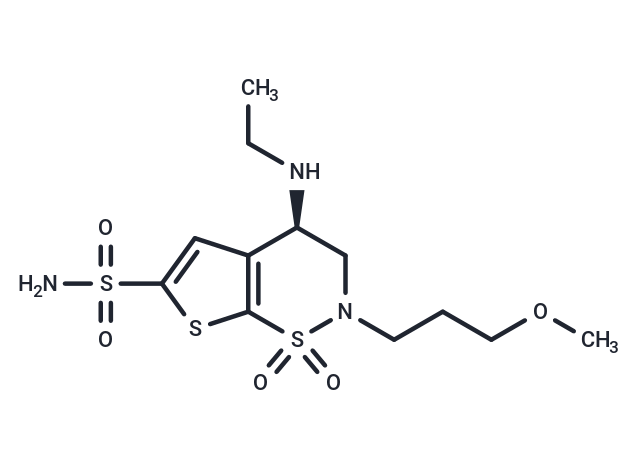Shopping Cart
- Remove All
 Your shopping cart is currently empty
Your shopping cart is currently empty

Brinzolamide (AL-4862) is a Carbonic Anhydrase Inhibitor. Its mechanism of action involves inhibiting the enzyme Carbonic Anhydrase.

| Pack Size | Price | Availability | Quantity |
|---|---|---|---|
| 10 mg | $30 | In Stock | |
| 25 mg | $58 | In Stock | |
| 50 mg | $89 | In Stock | |
| 100 mg | $130 | In Stock | |
| 500 mg | $272 | In Stock | |
| 1 mL x 10 mM (in DMSO) | $29 | In Stock |
| Description | Brinzolamide (AL-4862) is a Carbonic Anhydrase Inhibitor. Its mechanism of action involves inhibiting the enzyme Carbonic Anhydrase. |
| Targets&IC50 | CA II:3.19 nM |
| In vitro | A 0.6 mg dose of Brinzolamide ophthalmic suspension reduces intraocular pressure in a dose-dependent manner in cynomolgus monkeys post-laser glaucoma surgery. Similarly, it lowers intraocular pressure in Dutch belted rabbits. Dosages of 1 mg/kg, 10 mg/kg, and 30 mg/kg of Brinzolamide prolong the sleep time induced by barbital in male CD-1 mice by 57%, 15%, and 35%, respectively. Less than 3% of Brinzolamide significantly increases both the percentage reduction and the mean decrease in intraocular pressure among patients with primary open-angle glaucoma or ocular hypertension compared to a placebo group. Additionally, a 2% Brinzolamide solution enhances optic nerve head blood flow and reduces intraocular pressure in resting Dutch belted rabbits. |
| Alias | AL-4862 |
| Molecular Weight | 383.51 |
| Formula | C12H21N3O5S3 |
| Cas No. | 138890-62-7 |
| Smiles | O=S1(=O)C2=C([C@@H](NCC)CN1CCCOC)C=C(S(N)(=O)=O)S2 |
| Relative Density. | 1.50 g/cm3 (Predicted) |
| Storage | Powder: -20°C for 3 years | In solvent: -80°C for 1 year | Shipping with blue ice. | |||||||||||||||||||||||||||||||||||
| Solubility Information | H2O: < 1 mg/mL (insoluble or slightly soluble) Ethanol: < 1 mg/mL (insoluble or slightly soluble) DMSO: 60 mg/mL (156.45 mM), Sonication is recommended. | |||||||||||||||||||||||||||||||||||
Solution Preparation Table | ||||||||||||||||||||||||||||||||||||
DMSO
| ||||||||||||||||||||||||||||||||||||

Copyright © 2015-2024 TargetMol Chemicals Inc. All Rights Reserved.